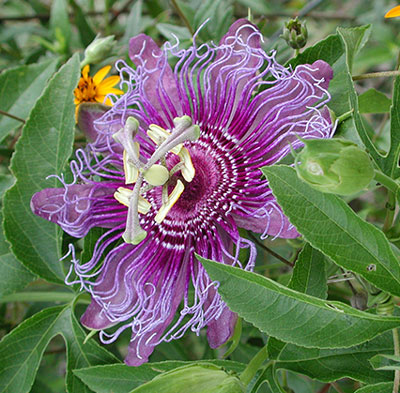From the Magazine: June 2015

Passion vines (Passiflora) come in hundreds of varieties. This purple Texas native displays the unique “crown of thorns” corona, long associated with the Passion of Christ. Photos by Mary Wilhite.
by Mary Wilhite
The Legendary Passion Flower
A striking, unique and tough vine for much of Texas
Passion flowers (Passiflora) are so incredibly beautiful and exotic it is hard to believe that many varieties are hardy and easy to grow in Texas. Purple passion flower (P. incarnata) is a Texas native vine, perennial in even the coldest parts of the state and known for its edible fruit as well as attractive flowers and foliage. With more than 500 varieties available, it is hard to choose which passion vine to try next in the garden.
The unusual shape of the blossoms of Passiflora gave rise to its common name, passion flower. Legend has it that a Jesuit priest saw various parts of the flower as symbols of the last days of Jesus and his crucifixion. The 10 petals and sepals have long been said to represent the 10 faithful apostles. The three stigmas at the top of the flower represent the three nails, and the five anthers below, Christ’s wounds. The flower’s corona, which is made up of wavy filaments, represents the crown of thorns.
Passion vines not only hold religious symbolism, they have been used for centuries for medicinal purposes. Native peoples have harvested all parts of the foliage, flowers and fruit to treat various ailments, including insomnia, stress and epilepsy. Fruits of purple passion flower, known as maypops because of the sound they make when stepped on, can be eaten like pomegranates. Just split open the yellowed pod, remove the seed and extract the clear gel covering the seeds to use in making juice or preserves.

The red passion vine (Passiflora vitifolia) features striking crimson blooms with white inner filaments.
Modern gardeners choose passion vines for their handsome foliage and glamorous flowers, as well as their easy care and vigorous growth. In most of Texas, the hardy passion vines go dormant in the winter then pop up from the roots in spring. They can grow several inches per day, and many yards long in one season. The twining tendrils cling to just about any kind of support and help the vine scramble up in search of sunlight. Smooth stems hold large, three- or five-lobed leaves. Flowers develop in midsummer, and blooming lasts until the first frost. Mature vines display numerous flowers for a striking show.
Although drought-tolerant, passion vines produce more flowers and fruit, in the case of maypops, with regular watering. They thrive in the heat of summer and prefer at least half a day of direct sun. As with most flowering vines, over-fertilization will produce lush green foliage but inhibit flowers.
Passion vines are not prone to root or foliar diseases if grown in well-drained soils. They are not bothered by garden pests, but are exclusive hosts to the caterpillars of several butterflies, particularly the Gulf Fritillary. These wicked-looking caterpillars with their thorny backs are voracious eaters and can consume all parts of a large, mature vine in a matter of days. The vines usually survive this severe treatment and leaf back out later in the season.
Most Passiflora varieties are tropical plants and will not survive the winter in any but the southernmost part of Texas, but several are hardy and available in many garden centers during the summer. Here are some of the most common varieties found in Texas.
• Purple passion vine (P. incarnata). This is the native Texas maypop with five-lobed leaves and flowers with pale blue petals and sepals. It is a vigorous grower and can smother a tree after several years. It spreads by runners and seed and is hardy in all parts of the state.
• Blue or common passion vine (P. caerulea). The 3- to 5-inch-wide flowers with white petals and blue coronal filaments emit a sweet scent. It is one of the hardiest passion flowers.
• P. Alatocaerulea. A hybrid with more rounded leaves than other varieties and large, fragrant flowers. The foliage is not as attractive to caterpillars as some other varieties. This one needs some winter protection in the northern half of Texas.
• ‘Incense’. A hybrid with large, sweetly scented, rich-purple flowers and wavy purple filaments. It has been very winter hardy for us here in Northeast Texas.
• Red passion flower (P. vitifolia). Lovely crimson-colored blooms with deep red filaments adorn this vine. It is root-hardy to Zone 8.
Many other passion flower varieties are available from Internet nurseries and are definitely worth growing if you have a greenhouse in which to protect them in the winter. The strikingly beautiful flowers of these exotics make them worth the effort.

